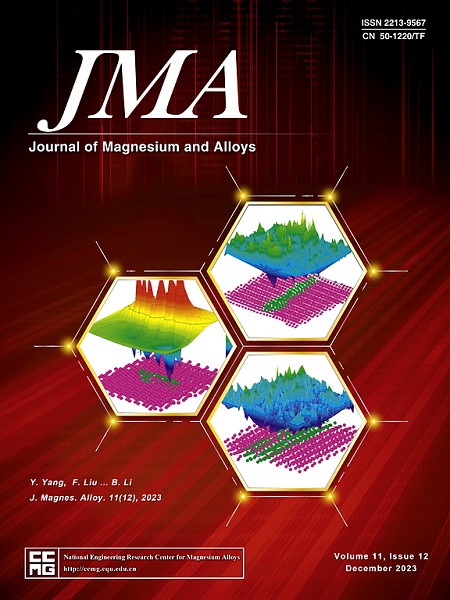Abnormal grain growth mechanism and inhibiting strategy by a tailored two-step solution treatment of ZK60 Mg alloy
IF 15.8
1区 材料科学
Q1 METALLURGY & METALLURGICAL ENGINEERING
引用次数: 0
Abstract
Mg profiles extruded through porthole die inherently contain longitudinal welds, which can readily induce the abnormal grain growth (AGG) in solution treatment at elevated temperature. Here, a strategy of two-step (primary and secondary) solution is tailored to inhibit AGG. The results indicate that AGG during primary solution can only be suppressed when the temperature drops below 300 °C, while these samples experienced AGG during secondary solution. It is interesting that the width of abnormal grain after secondary solution significantly decreases from 1,473 to 71 µm with increasing the holding time of primary solution from 3 to 84 h. This inhibiting effect results in notable enhancements in mechanical properties, where the elongation, initial fracture points, and maximum bending force are improved by 88.58 %, 32.63 %, and 128.50 %, respectively. The dislocation density and types of the precipitated phases after primary solution are the main factors for inhibiting AGG. First, the dislocation density decreases with increasing the time of primary solution, reducing the stored energy in grain interior. Second, as the primary solution time is extended, MgZn2 phases greatly become coarsening, accompanied by a transition in their relationship with α-Mg from coherent to semi-coherent. Moreover, the quantities of Mg4Zn7 (non-coherent with α-Mg) and Mg2Zn3 (semi-coherent with α-Mg) undergo a substantial increase, contributing to a high interfacial energy that effectively inhibits the grain boundary migration during secondary solution.

ZK60镁合金两步固溶处理的异常晶粒生长机理及抑制策略
通过孔型挤压成形的Mg型材固有地含有纵向焊缝,在高温固溶处理中容易诱发异常晶粒长大。在这里,一个两步(主要和次要)解决方案是量身定制的抑制AGG的策略。结果表明,当温度降至300℃以下时,初级溶液中的AGG才会被抑制,而次级溶液中的AGG则会被抑制。有趣的是,随着一次溶液保温时间从3小时增加到84小时,二次溶液后的异常晶粒宽度从1473µm显著减小到71µm。这种抑制作用显著增强了材料的力学性能,伸长率、初始断裂点和最大弯曲力分别提高了88.58%、32.63%和128.50%。位错密度和初溶后析出相类型是抑制AGG的主要因素。首先,位错密度随初次固溶时间的延长而减小,降低了晶粒内部的蓄能。其次,随着初溶时间的延长,MgZn2相显著粗化,与α-Mg的关系由共格向半共格转变。此外,Mg4Zn7(与α-Mg不共格)和Mg2Zn3(与α-Mg半共格)的数量也大幅增加,从而产生了较高的界面能,有效地抑制了二次固溶过程中的晶界迁移。
本文章由计算机程序翻译,如有差异,请以英文原文为准。
求助全文
约1分钟内获得全文
求助全文
来源期刊

Journal of Magnesium and Alloys
Engineering-Mechanics of Materials
CiteScore
20.20
自引率
14.80%
发文量
52
审稿时长
59 days
期刊介绍:
The Journal of Magnesium and Alloys serves as a global platform for both theoretical and experimental studies in magnesium science and engineering. It welcomes submissions investigating various scientific and engineering factors impacting the metallurgy, processing, microstructure, properties, and applications of magnesium and alloys. The journal covers all aspects of magnesium and alloy research, including raw materials, alloy casting, extrusion and deformation, corrosion and surface treatment, joining and machining, simulation and modeling, microstructure evolution and mechanical properties, new alloy development, magnesium-based composites, bio-materials and energy materials, applications, and recycling.
 求助内容:
求助内容: 应助结果提醒方式:
应助结果提醒方式:


